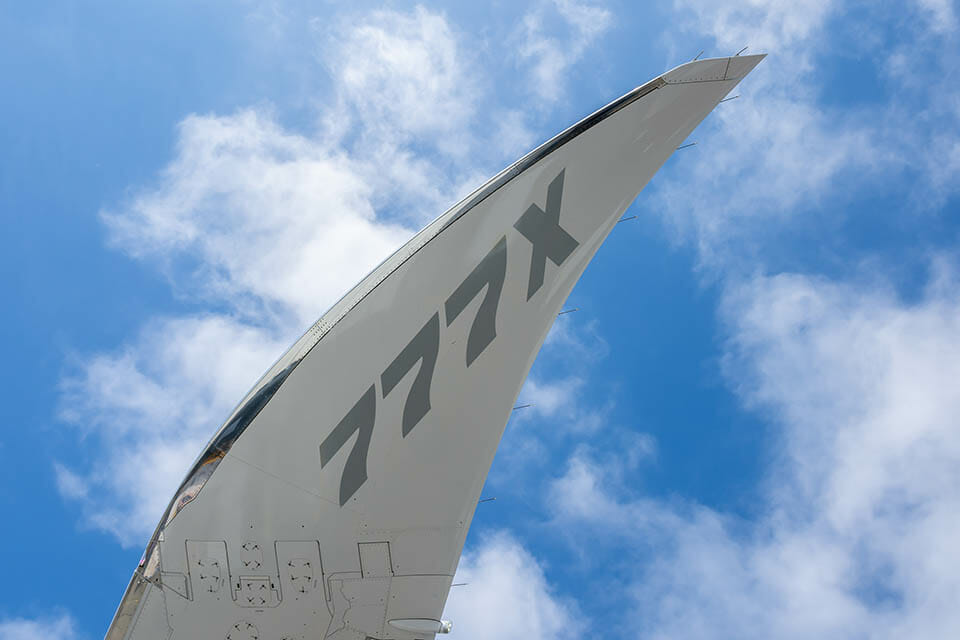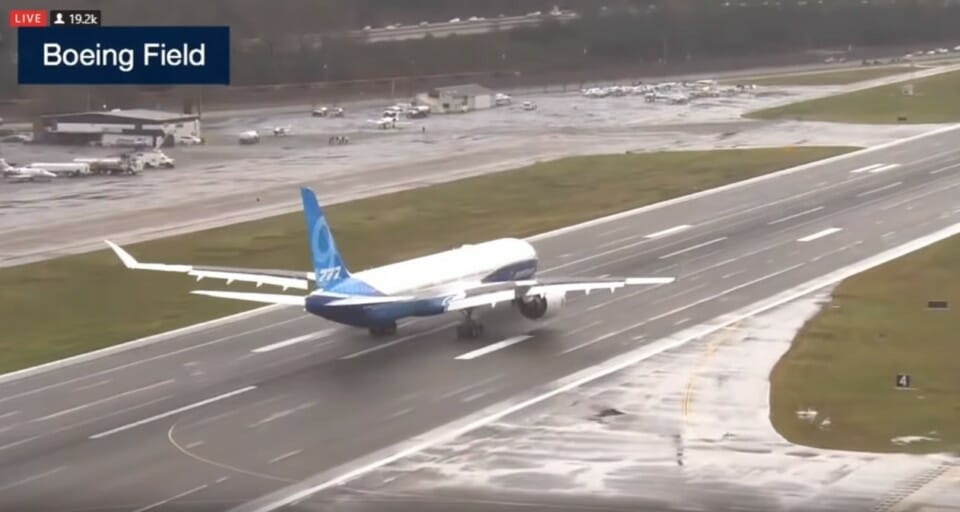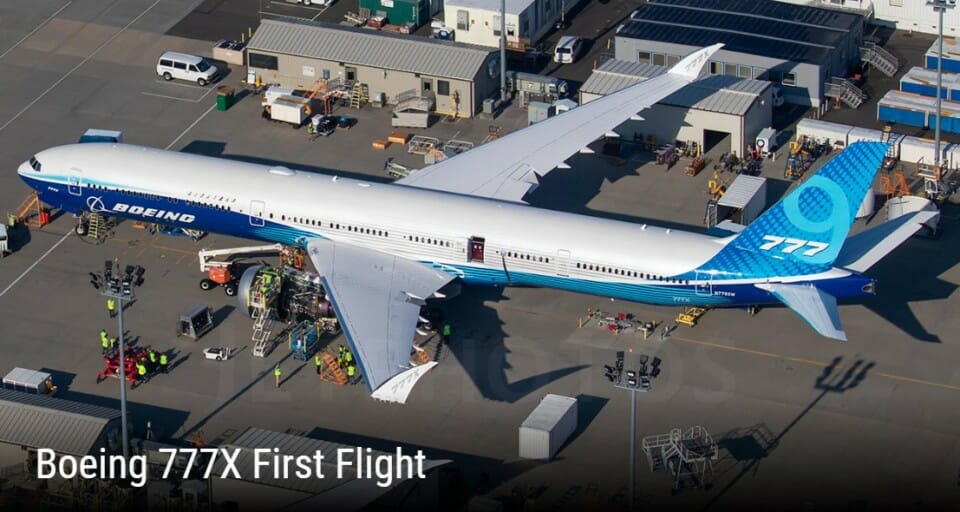Last Saturday, the Boeing 777-9 (777X) took off on its maiden test flight. The first flight lasted for hours for basic system checks and can be found here. One of the unique features of the 777X is the ability to retract the wingtips while on the ground.
The Challenge
The challenge for the 777X design team was to create a new wing with the additional lift required for the increased weight. The design requirements would need:
- Increased lift while reducing drag and
- The ability to utilize existing airports.
Increasing the lift is generally accomplished by increasing the wingspan. That was the easy part. The hard part was to allow the 777X the ability to land at existing International Civil Aviation Organization (ICAO) class E airports. The Airbus A380 requires an ICAO class F airport which allows operations at just 140 airports worldwide. Allowing operations within class E airports enables the 777X to compete with the Airbus A330 and A350XWB aircraft along with the existing 777 aircraft. The objective was for the 777X to using existing taxiways and terminal gates without having to upgrade airport facilities. Boeing chose a novel approach by using a folding wingtip. Carrier-based Navy aircraft have used folding wingtips for decades. This is the first time that folding wingtips are manufactured into civil aircraft.

The Solution
The design specifications called for a wingspan of 235 feet which is too wide to fit boarding gates at most airports. The decision was made to shorten the wingspan while on the ground to 212 feet by hinging the wingtips. This created an engineering challenge to the 777X design team to determine if this was possible and if so, how to accomplish this. Boeing engineers determined that this would be facilitated by retracting 11 feet of the wingtip. In the down positions, the wingtips would be secured into flight position by using a set of four pins to lock them into place. Since there are no commercial aircraft with this type of wing, Boeing would need a “special conditions” certification from the FAA before the engineering began.
The wingtips fold down and lock into place prior to takeoff. I was watching the first test flight last Saturday and I saw the wingtips deploy while holding short of the active runway. During the landing roll, the wingtips automatically retract when the aircraft slows to 50knots before it enters the taxiway.

The Requirements for FAA Approval
FAA CONCERNS
In applying for the special conditions request, the FAA had two key concerns:
“With wingtips in the folded position, the conventional airplane-wingtip-position lights may have reduced visibility due to the upward position of the wingtips, possibly impacting ground-operation safety. Light placement may require special consideration to retain the current ground-operation safety, and mitigate any adverse impact this light position may have on pilot visibility during night-lighting conditions.
Due to upward wingtip positioning on the ground, significant loads may be imposed by wind gusts combined with taxi speed during the transition from the unfolded to the folded position.”
FAA REQUIREMENTS
The directive from the FAA required Boeing to comply with 10 specific areas that needed to be addressed:
“1. More than one means must be available to alert the flightcrew that the wingtips are not properly positioned and secured prior to takeoff. Each of these means must be unique in their wingtip-monitoring function. …the applicant must add a function to the takeoff warning system …to warn of an unlocked or improperly positioned wingtip, including indication to the flightcrew when a wingtip is in the folded position during taxi.
2. …a means must be provided to prevent airplane takeoff if a wingtip is not properly positioned and secured for flight.
3. The applicant must consider the effects of … normal wear, and other long-term durability conditions (such as corrosion) of the folding-wingtip operating mechanism on freeplay, and its impact on loads and aeroelastic stability, … If lubrication is required to control excessive wear, lubrication intervals must be established. …The effects of freeplay on wing-joint torsional and bending stiffness, as well as wing frequencies, must be evaluated when showing compliance to loads and aeroelastic stability requirements. Also, the effects of freeplay on fatigue and damage tolerance must be considered …
4. The folding wingtips and their operating mechanism must be designed for 65 knot, horizontal, ground-gust conditions in any direction … Relevant design conditions must be defined using combinations of steady wind and taxi speeds determined by rational analysis utilizing airport wind data. … Runway roughness … must be evaluated separately up to the maximum relevant airplane ground speeds…
5. The airplane must demonstrate acceptable handling qualities during rollout in a crosswind environment, as wingtips transition from the flight-deployed to folded position, as well as during the unlikely event of asymmetric wingtip folding.
6. The wingtip-fold operating mechanism must have stops that positively limit the range of motion of the wingtips…
7. The wingtip hinge structure must be designed for inertia loads acting parallel to the hinge line…
8. … The forward position lights … must not impair the vision of the flightcrew when the wingtips are in the folded and transient positions.
9. The applicant must include design features that ensure the wingtips are properly secured during ground operations, to protect ground personnel from bodily injury as well as to prevent damage to the airframe, ground structure, and ground support equipment.
10. The wingtips must have means to safeguard against unlocking from the extended, flight-deployed position in flight, as a result of failures, including the failure of any single structural element. All sources of airplane power that could initiate unlocking of the wingtips must be automatically isolated from the wingtip-fold operating system (including the latching and locking system) prior to flight, and it must not be possible to restore power to the system during flight. The wingtip latching and locking mechanisms must be designed so that, under all airplane flight-load conditions, no force or torque can unlatch or unlock the mechanisms. The latching system must include a means to secure the latches in the latched position, independent of the locking system. It must not be possible to position the lock in the locked position if the latches and the latching mechanisms are not in the latched position, and it must not be possible to unlatch the latches with the locks in the locked position.
In Boeing’s application for the special conditions request, they were some interesting issues to note:
“Boeing has determined that a catastrophic event could occur if the Model 777-8 and 777-9 airplane wingtips are not properly positioned and secured for takeoff and during flight. In service, numerous takeoff operations with improper airplane configurations have occurred due to failures of the takeoff warning systems, or inadvertent crew actions.
…the applicant must show that such an event is extremely improbable, must not result from a single failure, and that appropriate alerting must be provided for the crew to manage unsafe system-operating conditions. In addition, the applicant must ensure that the wingtips are properly secured during ground operations to protect ground personnel against bodily injury.”
The summary of the special conditions report can be found here.
Are the Folding Wingtips Safe?
Airline passengers are more concerned about the safety than the mechanics of how it works. This is heightened by the safety issues surrounding the Boeing 737MAX. During ground testing, the folding wingtip worked as designed. The first test flight also showed that the wingtips performed accordingly.
What about takeoffs? Before an airliner takes off, the flight management computer runs through a set of parameters to determine if the aircraft is fully in takeoff configuration. Additionally, the prior-to-takeoff checklist will also require that the wingtips are deployed and locked before the takeoff roll can begin. There are redundancy measures employed to fully verify that the aircraft is in the proper takeoff configuration.
What about inflight safety? Boeing will need to demonstrate that the wingtip locking system will not fail during flight. Extensive testing will be performed at extreme conditions to ensure that the wingtips will not unlock during flight.
What about the landing? The wingtips are designed to retract automatically when the landing roll speed reaches 50 knots. At this point, if the wingtips fail to retract, it is not a safety issue but an operational issue. The aircraft could sit on a taxiway until the condition is resolved.
What’s Next for Testing
With a first flight completed to test basic system functionality, the testing program has a long way to go. This aircraft will undergo rigorous testing over months to ensure that safety and reliability are fully tested and certified. In the wake of the Boeing 737MAX disaster, you can be assured that the 777X will undergo intense scrutiny by the FAA before it obtains the airworthiness certificate required before it can enter airline service.



